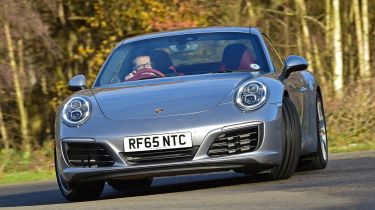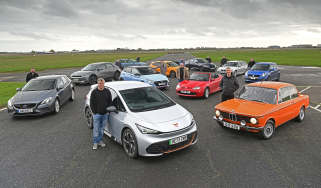Porsche 911 (2015-2018) review
The latest 991-generation Porsche 911 is undoubtedly one of the best handling sports cars in the world

The main Porsche 911 range now has turbo power – and it's just as good as ever. The addition of turbos to the 911 Carrera has brought even more usable performance and greater efficiency. The downside is that the racy soundtrack isn't quite as noticeable at the top end, but it still barks like a Porsche should, and with plenty of advanced chassis tech the 911 offers even more grip, poise and comfort than ever – decades of refining the package have clearly paid off.
• Best sports cars to buy right now.
The Carrera and GTS models now use tech from the halo Turbo and GT3 models, so the iconic sports car is still a class leader – and that extends to the interior, where there’s more equipment on offer than ever. With over 50 years of development behind it, the 911 is still one of the world’s best sports cars.
The Porsche 911 is a true motoring icon. Ever since the first model was launched in 1963, it's a car that has been synonymous with performance. And while the rear-engined layout meant earlier versions needed an experienced hand to get the best out of them, over 50 years of development has made the current 911 one of the most accessible sports cars on sale.
Used - available now
While the current car is known as the 911, that badge refers to the internal model code for the 1963 original. Since then, the 911 made way for the 964 series in 1989, which was then replaced by the 993 in 1994, then the 996 (1998), 997 (2005) and then the current 991 generation, which arrived in 2012. Either way, because the original was around for so long, the name stuck, and every version of Porsche's flagship coupe has been called the 911.
The links between the original 911 and each new generation get fewer and fewer, but the current car is still clearly a development of its ancestor. In reality, the only mechanical connection between the two is the fact the engine is mounted behind the passenger compartment, as over the years air cooling has made way for water cooling, the engine has crept further forward to improve the handling, and now turbocharging is common throughout the range.
While the 991-generation model arrived in 2012, it was only in 2015 that turbo power finally made it to every mainstream model. That year's Carrera and Carrera S replaced their respective 3.4 and 3.8-litre flat-sixes with a 3.0-litre twin-turbo flat-six with two different power outputs, and this engine has subsequently been added to the new Carrera GTS, too, which arrived in 2016. The only exceptions to the turbo rule are the track-focused GT3 and GT3 RS, which use a naturally aspirated 4.0-litre flat-six.
The current 911 range is available in Carrera Coupe, Carrera Cabriolet and Targa body styles, and there are standard, S and GTS versions of each. The Turbo and Turbo S variants are the grand tourers of the range - although they still handle superbly - while Porsche offers a variety of limited-run, track-focused 911s, including GT2 RS, GT3 and GT3 RS variants, depending on the point in the model's life cycle.
In addition, Porsche launched the 911 R in 2016. This model features the 4.0-litre flat-six and stripped-out cabin from the GT3 RS, but has a six-speed manual and is unadorned by race-style wings and spoilers. New models for 2017 included the limited edition Turbo S Exclusive, extreme GT2 RS and Carrera T.
While the models at the top of the range have been great earners for Porsche and speculators alike, it's arguable that the basic 911 Carrera is all the sports car you'd ever need. It has 365bhp, and comes with a seven-speed manual gearbox as standard, while Porsche's excellent PDK twin-clutch auto is available for a bit extra. This drops the 0-62mph time from 4.6 seconds to 4.4 seconds, while emissions and economy are improved, too.
The Carrera S has the same engine with 414bhp and seven-speed manual. It too can be had with the PDK box, and this model manages 0-62mph in 4.2 seconds, compared to 4.3 seconds for the manual. The GTS has 444bhp, and manages 0-62mph in 4.1 seconds in manual guise, while launch control helps the PDK-equipped version manage it in 3.7 seconds.
These models are also offered in four-wheel drive Carrera 4, Carrera 4S and Carrera 4 GTS forms - all of which a tenth or so off the 0-62mph times, and are available in Cabriolet body styles. The Targa is 4WD only, so comes in Targa 4, Targa 4S and Targa 4 GTS guises, although all versions are the same price as their respective Cabriolet counterparts.
The Turbo and Turbo S come with four-wheel drive and PDK gearboxes as standard. Using launch control, they manage 0-62mph in 3.0 seconds and 2.9 seconds respectively, while the Turbo S has a top speed of 205mph, making it the fastest production 911. While the S is significantly more expensive than the standard Turbo, it outsells it 2 to 1, as it's popular with buyers who simply want one of the fastest and most expensive 911s you can buy. That's the 911 Turbo S Cabriolet, which comes in at just over £155,000.
As there's a wide range of 911 variants, that means there are plenty of rivals to it, although none can quite match its ability. The Mercedes-AMG GT and Jaguar F-Type are obvious opponents, and four-seater coupes like the Audi RS5, BMW M4 and Mercedes-AMG C 63 are worth considering, too, as is the Nissan GT-R. The 911 Turbo is a rival to cars such as the Audi R8, Lamborghini Huracan and Honda NSX.
The GT 911s are more track-focused, so could be considered a rival to race-derived models such as the McLaren 570S, Aston Martin V12 Vantage S, and track specials like the Caterham Seven and Ariel Atom.








